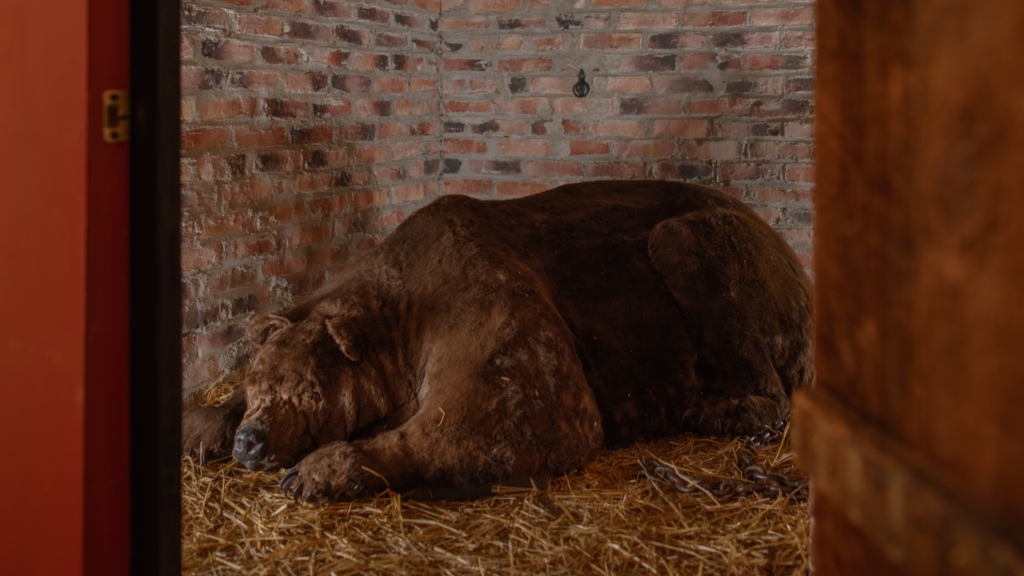Bu içerik, Pittsburgh’taki Troy Hill Sanat Evleri’nde yer alan sanat enstalasyonları hakkında bilgi vermektedir. Bu evler, dışarıdan normal bir görünüme sahipken içeride farklı sanat dünyalarına davet eden eserler barındırmaktadır. “Mrs. Christopher’s House” adlı ev, Mark Dion tarafından oluşturulmuştur ve ziyaretçilere farklı dönem odalarını keşfetme imkanı sunmaktadır. Ayrıca, diğer sanatçıların yaptığı eserler olan “Darkhouse Lighthouse”, “Kunzhaus” ve “La Hütte Royal” da halka ücretsiz olarak ziyaret edilebilmektedir. Sanat evlerinin, geçmişte yaşamış insanların hikayelerini ve objelerini yansıtan detaylarıyla, tekrar tekrar ziyaret edilerek keşfedilmesi amaçlanmaktadır. Sanat eserlerinin kalıcı olması, geçmişe ve geleceğe dair düşündürücü katmanlar barındırması önemli bir kriter olarak belirtilmektedir.
Kaynak: www.npr.org

A stuffed bear, its chain broken, is just one of the objects in “Mrs. Christopher’s House.”
Rebecca Kiger/Troy Hill Art Houses
hide caption
toggle caption
Rebecca Kiger/Troy Hill Art Houses
You’d never know, from walking around this quiet, residential neighborhood in Pittsburgh, that inside one of the houses is a (taxidermized) bear. Or a full-sized lighthouse. Or a secret passage through a fireplace.
Outside, there’s vinyl siding. But the insides of the four Troy Hill Art Houses are art installations that yank visitors into four very different worlds.
The latest, “Mrs. Christopher’s House,” which opened this fall, is from conceptual artist Mark Dion, whose work has been shown at the Tate Modern, and the Museum of Modern Art in New York. He’s best known for thinking about how we collect and display objects, what it says about us and how we think about the past.

Conceptual artist Mark Dion lives in upstate New York.
Jorge Colombo
hide caption
toggle caption
Jorge Colombo
Dion created “Mrs. Christopher’s House” to be a time machine, he said. And indeed, inside, visitors explore several different period rooms: there’s the medieval door that hides the taxidermized bear, sleeping in a bed of straw, its chain broken; a re-creation of a 1960s living room decorated for Christmas; and an art gallery from the 1990s with piles of mail on the desk and photographs of taxidermized polar bears on display in natural history museums around the world.
Then there is the “Extinction Club.” The wallpaper is all drawings of extinct animals, like the woolly mammoth and the Tasmanian tiger. And in the corner, there’s a cage with a door open — and a dead canary at the bottom.
“It’s very much making reference to the tradition of the of the miners canary,” Dion said. “And, you know, something’s gone terribly wrong when the bird stops to sing.”

The “Extinction Club” looks like a gentlemen’s club from the 1920s — but the walls are covered with images of extinct animals like dodos and Tasmanian tigers.
Rebecca Kiger/Troy Hill Art Houses
hide caption
toggle caption
Rebecca Kiger/Troy Hill Art Houses
A visit to Japan
Dion and three other artists were commissioned to create whole-house works of art for the Troy Hill Art Houses by collector Evan Mirapaul. In 2007, Mirapaul visited Naoshima, an island on the coast of Japan that has transformed seven of its abandoned houses into “art houses.”
“I don’t think I’d seen anywhere else where an artist was able to engage with an entire building, and have the entire building be the work,” Mirapaul said.
Also, he said, he liked that the art houses were in a residential neighborhood. “You’d walk down a little lane and you’d see, you know, Mrs. Nakashima working in her garden. And then next door would be the James Terrell house. It just kind of coexisted in a way that I thought was both satisfying and important.”
When he moved to Pittsburgh from New York, “I stole the idea wholesale . . . and started inviting people,” he said. “And here we are.”
A working lighthouse

Lenka Clayton and Phillip Andrew Lewis stand next to the base of their working lighthouse, built within a Pittsburgh row house.
Jennifer Vanasco
hide caption
toggle caption
Jennifer Vanasco
The houses are intended to be permanent installations, instead of temporary gallery exhibits. That was one of the reasons that artists Lenka Clayton and Phillip Andrew Lewis chose to build a full-sized, working lighthouse inside the Pittsburgh house they were given, which they call “Darkhouse Lighthouse.”
“I come from Cornwall, where there where a lighthouse is a very familiar part of the architecture,” said Clayton.
Lewis added that they wanted to make something that could serve a function in the future. “So we had this idea that in like 300, 500 — or five years from now, when the ocean rises, this lighthouse could sort of be unveiled, sort of like a time capsule.”
The ocean could wash up to the lighthouse’s doorstep, the light could be activated, and it “could be a beacon,” Clayton said.
Visiting the Troy Hill Houses

The outside of artist Robert Kuśmirowski’s “Kunzhaus” looks ordinary…except for the graveyard he installed in the back.
Tyler Banash/Troy Hill Art Houses
hide caption
toggle caption
Tyler Banash/Troy Hill Art Houses
All four houses — “Mrs. Christopher’s House,” “Darkhouse Lighthouse,” Polish artist Robert Kuśmirowski’s “Kunzhaus” and German artist Thorsten Brinkmann’s “La Hütte Royal” (that’s the one with the secret passage) are open to the public for free by appointment. Curators guide visitors through the houses.
Tours take about one hour each, but Mirapaul said they are meant to be viewed again and again.
“People ask me, how do I choose the different artists for the pieces? I don’t have any strict criteria,” Mirapaul said. “But the one of the things that’s very important to me is that an artist can create a work that is layered and complex enough to reward multiple visits.”
People come back “two, three, five, eight times,” he said. “And that thrills me.”

Mark Dion’s diorama imagining what Christmas 1961 may have looked like in “Mrs. Christopher’s House” — back when it actually belonged to Mrs. Christopher.
Rebecca Kiger/Troy Hill Art Houses
hide caption
toggle caption
Rebecca Kiger/Troy Hill Art Houses
Edited for air and digital by Ciera Crawford. Broadcast story mixed by Chloee Weiner.



Yorumlar kapalı.